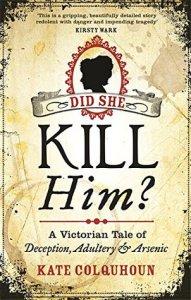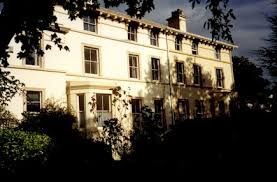
 Non-Fiction
Non-Fiction
5*s
Florence Maybrick is fast becoming the specialist subject I would choose for Mastermind as she has popped up in several of the books I’ve read about poisoners, during my current fascination with this method of murder, as well as on her own in Mrs Maybrick written by Victoria Blake.
For those who are less familiar with this Victorian lady living in Liverpool and tried for murder in August 1889, in fact I was reading this 127 years to the day the verdict was passed. Florence had publicly argued with her husband in the spring of 1889 and then almost immediately afterwards he fell ill, seemingly rallied and then died. Shortly before his death the first hint of poisoning being the cause of his malaise were whispered in the well-upholstered corridors of Battlecrease House in suburban Aigburth, the house the family rented in order to keep up a suitable presence amongst their peers.

Battlecrease House
With arsenic being the suspected poison much was made of a dish of fly-papers found soaking by the maid Bessie in Florence’s bedroom and this added to whispers about the appearance and smell of the food sent to the sick room altering whipped up a hotbed of suspicion in the household. When the nursery nurse the fabulously named Alice Yapp, on opening a letter written by Florence to another man decided to hand it to a family friend, the die was cast for Florence and James’s elder brother Michael was summoned home to take control in the last days of James’s life.
I really enjoyed Kate Coluhoun’s book about this interesting crime the mystery of whether Florence did kill James, something which I think is still in question today. She starts the book by building up Florence with a more sympathetic characterisation than some authors have treated her to, but more than that, by using her imagination against a backdrop of superb research, treats the reader to a version of what life was like for the twenty-six year old American woman living the life as a wife to a cotton trader.
In a while she would call Bessie to take it to the post. For the present her tapering fingers remained idle in the lap from which one of her three cats had lately jumped, bored by her failure to show it affection.
Today, the twenty-six year old was wonderfully put together her clothes painstakingly considered if a little over-fussed. Loose curls, dark blonde with a hint of auburn, were bundled up at the back of her head and fashionably frizzed across her full forehead.
Of course Kate Colquhoun can’t know for sure how Florence felt for sure but her account seemed as likely as any other to me, and by writing in this style the book is far more readable than one where we are just presented with the known facts. The backing up of her attestations with historical accuracy especially in respect to the change of heart that the nation had as the trial proceeded was fascinating. Many commentators were convinced of Florence’s guilt at the start of the trial but opinion in some quarters at least turned, and the talking point became less about Florence’s transgressions and more about the facts. To help the reader understand these fluctuations the change in attitudes is painted using the arts as a barometer with regular notes on the type of romantic fiction Florence herself read, as well as the still well-known contemporary fiction. Paintings of the time are also looked at with an eye on how women were viewed at this time and the hints of how things were changing. This after all was at the start of the suffragette movement and this caused alarm for those who held the ‘old’ social mores in high regard.
After starting in such a sympathetic manner to Florence the end of the book, by contrast then almost re-examines the evidence from another perspective, re-examining the questions that had been given a plausible answer earlier in the book. I found this intriguing and of course underlines the fact that no-one really knows whether the pretty young woman tried to kill off her husband or whether circumstances conspired against her to make it look as though she might have.
This was altogether an interesting and thoughtful look at the life of a middle-class wife in late Victorian England where times were just beginning to change but too late for those who were stuck with a role that didn’t provide them satisfaction in the narrow role they were forced to live.
I’ve heard great things about Kate Colquhoun’s previous book Mr Briggs’s Hat so you can expect to see that one appear on my bookshelf to read and review soon.
Published UK: 15 October 2014
Publisher: Overlook Press
No of Pages: 419
Genre: Historical True Crime
Amazon UK
Amazon US


